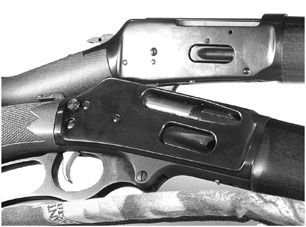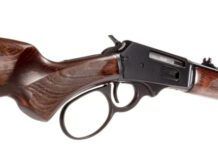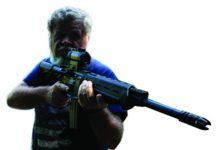
Though the world of lever-action rifles has been resuscitated because of Cowboy Action Shooting, there’s a segment of the hunting population that never left .30-30s as workhorses in the field. It has been said, probably with some accuracy, that more deer have been taken with the venerable .30-30 than any other cartridge, and by extension, lever-action rifles.
Gun Tests wanted to take a close look at two guns suitable for close-in brush hunting, where scopes are optional and fast handling is desired. Our test guns were the Marlin 336W and the Winchester Ranger, those two companies’ low-end guns. The Marlin can be had for as little as $255 (a retail price we found during a Wal-Mart sale), though its regular retail price was $280 and its MSRP is $482. It came equipped with sling swivels and a padded nylon camo-colored sling. The Winchester Model 94 Ranger with tang safety cost a little more. Because we had a retail price for the Marlin, we asked what price Wal-Mart would have ordered the gun for (it wasn’t in stock). The number was $295. The Winchester’s MSRP is $377.
Of course, both guns are lever action, tubular fed, and have exposed hammers and open sights. Both guns enjoy hardwood stocks, but the Marlin is a pistol-grip shape, while the Winchester is a straight grip. Each has open iron sights, and that’s how we conducted our accuracy testing.
They both chamber the .30-30 Winchester cartridge, of which we fired three bullet brands. The heaviest was the Remington 170-grain Core-Lokt softpoint No. R30302, followed by two 150-grain bullets, the Winchester 150-grain Power-Point No. X30306, also a soft-point design, and the PMC Starfire 150-grain hollowpoint No. C3030SFA.
During this head-to-head test, each rifle was fed 100 rounds of ammunition. Accuracy testing was done on an outdoor range at 50 yards using a rifle rest and open sights. For accuracy and chronograph testing, we fired five five-shot groups with each ammunition. Accuracy and velocity results are recorded in the accompanying table.
Here’s what we thought of these two hunting guns:
[PDFCAP(1)]
John Mahlon Marlin opened his New Haven gun shop for business in 1870 to start what has become one of the industry’s largest operations. Marlin is renowned for design longevity; the models 39 and 336 are the oldest shoulder arm designs in the world still being produced.
One of the interesting things about this match up is the historical battle these companies have waged. During the 1870s, Winchester was enjoying success with a line of lever-action repeaters for medium power cartridges. While they didn’t have the power of the big single-shot rifles, they offered repeating rifle firepower and opened a market Marlin wanted to enter. John Marlin’s team developed the Marlin Model 1881, a rugged repeating lever rifle first offered in .45/70 Govt. By combining .45/70 power with a repeating rifle, Marlin produced an outstanding combination for a ready market. When the .30/30 introduced smokeless powder, Marlin quickly added that caliber. Designation of this rifle was changed to Model 336 in 1948, when a round bolt was substituted for the original square one to strengthen the action. Well over 3 million 336s have been made since the original 1893 was introduced.
Other Model 336s include the 336Y Spikehorn, notable because of its 16.5-inch long barrel and 34-inch OAL; the 336SS, which you might guess has a 20-inch stainless barrel and stainless receiver; the 336C, which is differentiated from the 336W because of its walnut stock and availability of .35 Rem chambering; and the 336A, which lacks the W’s sling, among other differences.
The company says the 336W was “created for the no-nonsense deer hunter.” It has a six-shot tubular magazine underneath a 20-inch-long Micro-Groove barrel (1:10 right-hand twist). The gun has side ejection and a solid-top receiver, and its metal is blued throughout, save for the gold-plated trigger. The receiver is tapped for a scope mount. The sights are screw-adjustable open rear with a white front bead under a Wide-Scan hood. The walnut-finished Mar-Shield-coated birch stock has cut checkering and comes with sling swivels and a Realtree-camo padded nylon sling. The gun weighed 7 pounds and measured 38.25 inches in overall length.
Our 336W’s fit and finish were very good. Its steel barrel and action had an evenly blued finish with a medium polish. We noticed no sharp edges on the ejection port or the bolt, but we would probably knock off the edges of the squared hammer, which gouged us a couple of times. The lever had very little side-to-side play, either open or closed. It had a firm lockup when snugged against the stock—noticeably better than the Winchester, we thought.
This Marlin’s checkering was neatly cut on the pistol grip and forend, and this feature helped handling, we thought. The blued steel barrel band and the black-plastic buttplate were expertly installed, though we saw minor tool marks in the buttplate plastic. Both portions of the stock were carefully mated to the rest of the gun.
At [PDFCAP(2)], the 336W functioned flawlessly with the ammunition we used. Inserting cartridges into the tubular magazine through the loading port in the right side of the receiver was easier than when we loaded the Winchester, we thought. Spent cases were ejected about 1 foot to the right.
We felt this Marlin’s handling was more than satisfactory for its intended use. It wasn’t too heavy, and the gun balanced between the hands, much like a shotgun. Shouldering was fast and consistent, and the buttplate fit the shooter’s shoulder well, though we would replace the plastic buttpad with a softer rubber one.
The stock’s wide comb provided a very good cheek-to-stock fit. Shooters who extend their elbows off the body when shooting standing thought the 9.75-inch-long forend was a bit short, but it and the pistol grip afforded a secure grasp. The kick and muzzle flip generated during recoil was mild with the 150-grain rounds, a little stiffer with the 170-grain bullets..
All of our shooters could readily cock the external hammer with the thumb of their firing hand. However, the crossbolt safety’s operation was better for right-handed shooters than southpaws. When pushed from left to right, it prevented firing by blocking the hammer from moving forward far enough to reach the firing pin. The crossbolt couldn’t be moved unless the hammer was pulled back slightly. There was a half-cock notch on the hammer.
The movement of its ungrooved 0.25-inch-wide trigger was acceptably clean and light. After no noticeable creep, its pull released at 5.1 pounds. There was a small amount of overtravel in the movement.
In our opinion, the 336W’s open sights provided a well-defined sight picture. The front blade had white bead under the hood. The rear consisted of a semi-buckhorn blade with white windage reference markings under its U-shaped notch. The rear sight was step-adjustable for elevation corrections.
To accommodate the installation of an optical sight, the top of the receiver was drilled and tapped for a scope mount. Included in the rifle’s shipping box was an empty package that said “offset hammer spur.” The clamp-on spur is needed to operate the hammer when a scope is installed.
Our shooters considered this Marlin’s accuracy to be average for a .30-30 rifle. Using the open sights at 50 yards, we fired two ammos (the Winchester and the PMC) into five-shot groups measuring just over 2 inches in width. Also, the Marlin produced noticeably higher velocities and energies with all three rounds.
[PDFCAP(3)]
The Ranger is one of 16 Model 94s produced by Winchester. The product range in price from the Heritage Limited Edition, $2,087, down to our gun, whose MSRP is $377. Other models include the Legacy octagonal 26-inch barrel (blued, $882; case-colored, $938); and Legacy round 26-inch barrel (blued, $783; case-colored, $839); as well as the 24-inch Legacy, $485; and Timber, available in .450 Marlin, $610.
Through the years, not much has changed from the original Model 94. The compact receiver (5.2 inches long compared to the Marlin’s 5.9 inches) gives the gun nice lines. There’s a tang-mounted safety instead of the Marlin’s crossbolt. The gun has a 20-inch round barrel and a six-shot tubular magazine. The gun has an open-top receiver and angle ejection.
Its workmanship was uneven, in our opinion. On the positive side, all steel surfaces had an evenly blued finish with a medium polish. We saw no tool marks on the sides of the bolt and no sharp edges, except we would knock the corners off the hammer. On the downside, most moving parts had much more play than the Marlin, especially the lever. When closed, the lever rattled side to side and up and down.
This Winchester’s hardwood two-piece stock had a satin finish, and we saw no sanding marks or finish flaws on the buttstock. The installation of the black-plastic buttplate wasn’t quite flush, and the front surfaces of the buttstock weren’t fit as tightly as the Marlin, in our opinion. A barrel band fastened the forend to the barrel. The gun lacked checkering, and it didn’t have sling swivels or a sling.
During live fire testing, the Ranger didn’t malfunction with the three kinds of commercial ammunition we tried. But loading rounds through the loading port in the right side of the receiver and into the tubular magazine wasn’t very easy. We had to push hard to overcome the magazine follower’s heavy return spring. In spite of a few hitches, the action’s movement was fairly smooth.
At 6.25 pounds, this Winchester was lighter than the Marlin, but both guns were evenly balanced. Shouldering was quick and natural. The nicely rounded comb provided a stable, comfortable cheek-to-stock fit. Most shooters thought the 9-inch-long forend was too short, but the straight grip could be grasped comfortably.
Cocking the external hammer wasn’t a problem. The manual safety was a pushbutton at the rear of the receiver. When the safety was pushed forward to fire, a red dot was exposed. This safety could be engaged and disengaged without retracting the hammer.
Like all Model 94s, the Ranger had two passive safeties. One was a trigger stop, which disengaged when it was depressed by the action lever, to prevent firing if the action wasn’t fully closed. The other was a rebounding hammer, which didn’t come into contact with the firing pin unless it was released by the trigger from the cocked position. This prevents firing if the gun is dropped or mishandled.
Movement of the ungrooved 0.25-inch-wide trigger was horrible, in our opinion. After a lot of hesitation, its pull released at 7.25 pounds. There was also a lot of overtravel, and the trigger felt spongy throughout its motion.
For sighting, the rifle had a dovetailed 0.06-inch-wide front blade with a bead formed as part of the post. The rear was a semi-buckhorn blade with a white triangle under its U-shaped notch. The rear sight was driftable for windage corrections and step-adjustable for elevation changes. We thought this arrangement provided a clean sight picture, but we much preferred the Marlin’s hooded version. The hood protects the front sight, of course, but it also keeps sunlight or glare from degrading the sight picture.
For those who prefer a scope, the top of the receiver was drilled and tapped for a scope base. A reversible offset hammer spur, which screws into a hole in the hammer, did not come with the rifle.
Our shooters felt this rifle’s 50-yard accuracy was on par with the Marlin with one ammo—five-shot groups averaged 2.2 inches with PMC’s 150-grain rounds. It shot 3.0 inches with Winchester’s 150-grain Power-Points, and 3.2 inches with Remington’s 170-grain soft points.
Gun Tests Recommends
• Marlin 336W .30-30, $255. Best Buy. This gun was well put together, shot accurately, and handled well. For the price, it’s a great buy.
• Winchester Ranger .30-30 No. 534087114, $295. Don’t Buy. This gun was more expensive, and lacked some of the niceties of the Marlin 336W: checkering, front-sight hood, sling swivels, sling, a decent trigger pull, to name a few. We wavered between awarded this gun a Conditional Buy and a Don’t Buy, mainly because the gun did do its job. But we really can’t see any reason to buy it unless you want top-eject or a tang-mounted safety. If you believe those two reasons are enough to outweigh the Marlin’s advantages, then consider it a Conditional Buy.






























I’m looking at a winchester 30-30 ranger but it has no model number on it for 800.00.
I’d like to know where you were able to find them for 300.00 and maybe that is why you were not happy with it, you get what you pay for type deal.
Hi I’m interested in the 30 30 what are you asking for it I’m a disabled veteran and I would like to have it
Sorry, Jack, we don’t sell our test firearms. Todd Woodard, editor